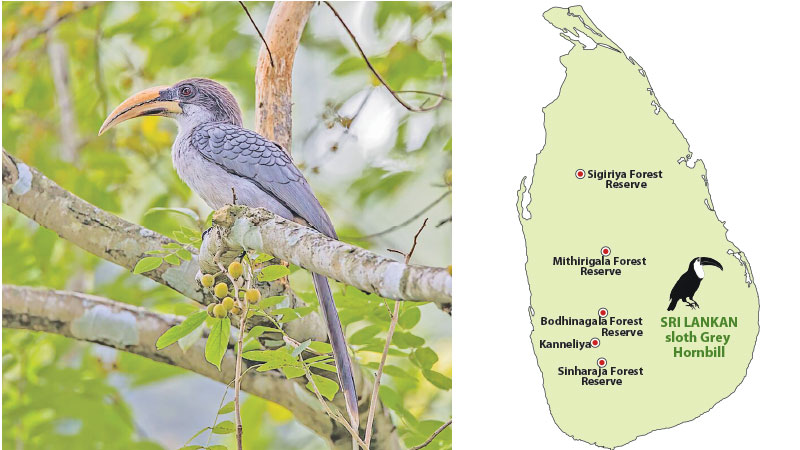Who is this bird?
The Sri Lanka Grey Hornbill, Ocyceros gingalensis is a large bird that’s found only in Sri Lanka. It has grey feathers, a long tail, and a huge curved beak that makes it look like it’s smiling all the time. And guess what? Even though it looks big and bold, it’s not a noisy bird. It usually glides quietly through the trees, hopping from branch to branch.
What does it eat?
This hornbill loves fruit—especially juicy ones like figs and berries. But it’s not a picky eater. Sometimes it munches on insects, small lizards, or even little frogs. That big beak helps it pick food easily, like a built-in fruit picker.
Secret nesting habits
Now here’s the best part—when it’s time to lay eggs, the female hornbill finds a hole in a tree, climbs inside, and lets the male seal her in with mud, fruit pulp, and droppings, leaving only a tiny crack open. She stays inside the tree for weeks, safe from danger, while she lays eggs and takes care of the chicks. The daddy hornbill brings her food through the tiny hole—what a helpful partner.
When the chicks are big enough, the mom breaks out of the nest and helps the dad feed the hungry babies.
Where can you spot one?
If you’re lucky enough to visit a rainforest, especially in the wet zone of Sri Lanka, keep your eyes and ears open.
You might spot one flying from tree to tree, or hear its special call—it sounds a bit like a laugh or a honking horn.
Some good places to see them include the Sinharaja Forest Reserve, Kanneliya, Meethrigala Forest Reserve, Kitulgala, Bodhinagala Forest Reserve, Morapitiya Forest Reserve, Hiyare Forest Reserve, and Sigiriya.
Why we must protect it
The Sri Lanka Grey Hornbill is not endangered right now, but its forest home is getting smaller every year.
If we want to keep seeing this amazing bird, we need to protect our forests, plant trees, and keep nature clean and safe.
Fun fact
* The hornbill can’t dig its own nest—it has to find a ready-made hole, often left by a woodpecker or a broken branch.
* Even though it has a huge curved beak, it’s very light, because it’s made of honeycomb-like bones with air inside.
* Their call sounds like a funny cackling laugh—if you hear it in the forest, it might sound like the bird is giggling.







